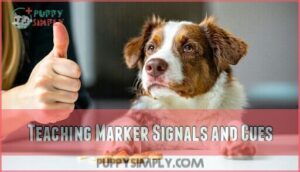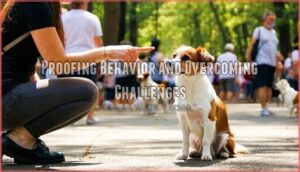This site is supported by our readers. We may earn a commission, at no cost to you, if you purchase through links.
 Training a deaf dog may sound tricky, but it’s all about using visual cues, clear hand signals, and lots of patience.
Training a deaf dog may sound tricky, but it’s all about using visual cues, clear hand signals, and lots of patience.
Start by teaching your dog to focus on you—use a gentle tap or a flashlight to get their attention.
Consistency is key when introducing hand signals for commands like sit or stay.
Pair these signals with rewards like treats or toys to reinforce good behavior.
Keep things upbeat and avoid startling them, as sudden moves can cause fear.
Over time, they’ll trust you and respond like a pro.
Ready to learn more? Let’s explore advanced techniques and tools next.
Table Of Contents
- Key Takeaways
- Training Deaf Dogs Basics
- How to Train Deaf Dogs
- Managing Deaf Dog Behavior
- Advanced Deaf Dog Training
- Frequently Asked Questions (FAQs)
- What should I know before adopting a deaf dog?
- How do you teach a deaf dog hand signals?
- How do you train a deaf dog?
- Are deaf dogs difficult to train?
- Is deaf dog training intimidating?
- Are there online resources for training deaf dogs?
- How do you discipline a deaf dog?
- What tools are used to train deaf dogs?
- What signs to teach a deaf dog?
- How do I ensure my deaf dog is safe outside?
- Conclusion
Key Takeaways
- Teach your dog to focus on you using gentle taps, visual cues, or a flashlight, and always reward good behavior.
- Use clear, consistent hand signals paired with treats to teach commands like "sit," "stay," and "come."
- Always approach your dog from the front to avoid startling them, and build trust with predictable routines and positive reinforcement.
- Leash your dog in open areas and teach recall with visual cues to ensure safety outside.
Training Deaf Dogs Basics
Training a deaf dog starts with mastering visual communication and consistent hand signals. Clear, distinct gestures and body language help your dog understand commands and build trust effectively.
Communication Methods for Deaf Dogs
Effective deaf dog communication relies on visual cues, body language, and custom hand signals.
Use ASL adaptations or create your own clear, distinct gestures. Pair commands with treats and repetition for success.
Vibration training, like stomping, can grab attention, while hand signals and sign language help dogs understand commands.
Consistency and clarity make all the difference in communication. Some breeds, like Dalmatians, have higher rates of deafness, requiring specialized training approaches.
Importance of Visual Cues
Like a silent symphony, visual communication becomes your deaf dog’s lifeline.
A silent symphony of hand signals and trust creates a bond that speaks louder than words.
Your body language, facial expressions, and hand signals are the primary tools for connection.
Cue clarity is essential—each gesture must be distinct and consistent.
By mastering visual cues, you’ll build a profound understanding that transcends sound, creating a deep, intuitive bond with your four-legged companion, based on silent symphony.
Using Hand Signals and Body Language
With deaf dogs, mastering visual communication becomes your primary training language.
Body language and hand signals are essential for clear, consistent commands. Develop custom signals that are distinct and easy to understand.
Whether you’re using American Sign Language or creating your own, signal clarity matters most. Your dog will quickly learn to read your visual cues with patience and practice.
How to Train Deaf Dogs
Training a deaf dog requires a consistent approach with clear hand signals, positive reinforcement, and plenty of patience.
By teaching your dog to focus on you and respond to visual cues, you can build a strong foundation for effective communication.
Teaching Focus and Attention
How do you build your dog’s focus without using sound? Start with Visual Focus and small Attention Games.
Use Touch Cues like a gentle tap paired with Positive Reinforcement. Practice in quiet spaces to reduce distractions.
Focus training helps your dog respond to visual cues and builds a strong connection. Crate training can also be effective, as it builds positive associations with a safe space.
- Teach "look at me" as a first step.
- Use treats to reward attention.
- Practice short sessions daily.
- Minimize noisy or busy environments.
- Be consistent with gestures and rewards.
Hand Signals for Obedience Commands
Hand signals are essential for deaf dog training, combining visual cues with consistent reinforcement. Start with simple commands like “sit” or “stay,” guaranteeing signal clarity. Use ASL adaptations or custom signals but keep gestures distinct for deaf dog commands.
Pair signals with treats to teach visual cues dogs easily recognize. Command generalization requires daily practice. As with any dog, positive reinforcement is vital for deaf dogs.
| Command | Hand Signal Description | Importance | Practice Tip | Key Focus |
|---|---|---|---|---|
| Sit | Palm up, raise hand | Promotes basic obedience | Reward instantly | Signal Clarity |
| Stay | Flat hand facing dog | Ensures safety | Extend duration gradually | Consistent Reinforcement |
| Come | Sweep hand toward yourself | Builds recall skills | Use high-value treats | Positive Association |
| Heel | Patting leg while walking | Improves leash manners | Reward with movement | Steady Focus |
| Lay Down | Move hand downward in an arc | Encourages calm behavior | Practice in low-stimulus areas | Predictable Signals |
Mark and Reward Training Techniques
Mark and reward training combines visual markers and positive reinforcement to shape behavior.
Use a consistent hand signal—like a thumbs-up—to mark correct actions. Timing is key; reward your dog immediately with a treat to reinforce the behavior.
This method bridges visual cues dogs understand with deaf dog training techniques, ensuring they learn deaf dog commands effectively through clear associations and consistency.
Managing Deaf Dog Behavior
Managing a deaf dog’s behavior starts with ensuring their safety and building their confidence through consistent training.
By using gentle techniques and staying mindful of their unique needs, you can help them thrive in any environment, which is crucial for their overall well-being and safety.
Safety Precautions and Leash Training
Leashes are your deaf dog’s lifeline to safety. They prevent off-leash risks, like running into danger or predators.
Focus your leash training on visual discipline, using hand signals to guide them. Build strong recall alternatives to guarantee control.
Here’s how:
- Use treats during leash dependence training.
- Practice in fenced areas first.
- Add gestures for deaf dog recall.
- Avoid distractions while training.
Consider using specialized deaf dog equipment during training to ensure a safe and effective learning experience for your deaf dog.
Avoiding Startle Responses and Fear-Based Reactions
Predictable approaches help with startle prevention in deaf dog training.
Always use a gentle touch to wake them and reward calm responses.
Avoid sneaking up on your dog—approach from the front to reduce anxiety.
Safe spaces are essential for their comfort.
Consistent positive reinforcement for relaxed behavior builds trust and guarantees deaf dog safety, even during sudden interactions.
Creating a predictable routine can help minimize separation and noise phobias and ensure deaf dog safety.
Building Trust and Confidence
Trust takes time but begins with consistency and kindness.
Build confidence by using positive reinforcement and a gentle touch to reassure your dog. Stick to predictable routines for a safe environment.
Here are five ways to bond:
- Introduce slow, calm socialization skills.
- Reward eye contact often.
- Use light pats for comfort.
- Maintain routine meals and walks.
- Practice patience.
Advanced Deaf Dog Training
Advanced training for your deaf dog focuses on refining their skills and building stronger communication through specialized techniques.
Using tools like marker signals, vibrating collars, and consistent cues guarantees clear understanding and better responsiveness.
Teaching Marker Signals and Cues
Marker signals are key in deaf dog training. Use a visual marker, like a thumbs-up gesture, to signal correct behavior.
Marker signals bridge the gap in deaf dog training, fostering clear communication and reinforcing behavior through consistent visual cues like a simple thumbs-up.
Pair it with rewards for positive reinforcement. Behavior marking helps your dog connect actions to outcomes.
Clear visual cues, such as distinct hand signals, guarantee consistency. Consider using distinct visual aids for clearer communication.
Cue pairing builds understanding and reliability, making training smooth and effective.
Using Vibrating Collars and Flashlights
Vibration collars and flashlight training expand your communication toolbox, building on marker signals.
A vibrating collar grabs attention without causing discomfort—adjust vibration intensity for collar sensitivity.
Flashlight training offers an alternative signal for remote communication.
Use clear, distinct signals:
- Pair vibration with visual cues like hand signals.
- Flash quick light bursts for commands.
- Prioritize consistency in all signals.
Basket muzzles, for example, allow panting and eating, which can be useful during training.
This tool is particularly helpful as it enables dogs to pant and eat while wearing the muzzle.
Proofing Behavior and Overcoming Challenges
After teaching advanced commands, focus on generalization training to guarantee your deaf dog responds in new settings.
Gradually add environmental distractions and stay consistent to prevent regression.
For problem behaviors, use positive reinforcement and solid deaf dog behavior modification strategies.
Overcoming deaf dog training challenges takes patience, but solutions like repetition and reinforcing responses build confidence and reliability in all situations.
Frequently Asked Questions (FAQs)
What should I know before adopting a deaf dog?
Taking in a deaf dog is like learning a new dance together.
Before adopting, prepare for consistent hand signals, safety measures, and specialized care.
Patience, research, and support will help you build a strong bond.
How do you teach a deaf dog hand signals?
Start by choosing clear, distinct hand signals for each command.
Consistency is key—always pair actions with rewards like treats or praise.
Use a thumbs-up as a marker for correct behaviors, reinforcing positive actions every time.
How do you train a deaf dog?
Training a deaf dog means relying on hand signals, consistent cues, and positive reinforcement.
Pair gestures with rewards and patience.
Use clear body language, establish routines, and guarantee their safety during every step of the process.
Are deaf dogs difficult to train?
Training a deaf dog isn’t harder, it’s just different.
With patience, consistent hand signals, and positive reinforcement, you’ll build trust and create an amazing bond.
Think of it as learning a new language together.
Is deaf dog training intimidating?
It’s natural to feel intimidated, but deaf dog training isn’t as overwhelming as it seems.
Once you master using hand signals, patience, and rewards, you’ll realize it’s all about building trust and connection.
Are there online resources for training deaf dogs?
Training a deaf dog might feel like climbing Mount Everest, but fear not—online resources abound!
Check out tutorials, forums, and videos designed for hand signals, positive reinforcement, and building confidence in your furry friend, using positive reinforcement.
How do you discipline a deaf dog?
Use visual cues like distinct hand signals to guide behavior, and reward positive actions with treats or gestures.
Avoid punishment; instead, redirect with clear signals.
Consistent communication builds trust and reinforces desired behavior effectively, and is essential for trust.
What tools are used to train deaf dogs?
You can rely on tools like hand signals, visual markers (like a thumbs-up), treats, vibrating collars, and leashes.
Each tool helps guarantee clear communication, safety, and consistent training for your deaf dog.
What signs to teach a deaf dog?
Start with essential signs like "sit," "stay," "come," and "down."
Add practical commands like "leave it" and "watch me."
Keep your signals simple, distinct, and consistent to make learning easy for your dog.
How do I ensure my deaf dog is safe outside?
About 36% of pet injuries occur outside.
Always leash your deaf dog in unfenced areas, use “I’m Deaf” tags, and teach recall with hand signals.
A secure, fenced yard guarantees freedom while prioritizing safety.
Conclusion
Training a deaf dog might seem challenging, but it’s simpler than you think with the right approach.
By mastering hand signals, staying consistent, and reinforcing behaviors with rewards, you’ll build a strong bond.
Focus on clear communication using visual cues, like flashlights or gentle taps, to guide them.
Remember, it’s all about trust, patience, and repetition.
With time and effort, your pup will thrive, proving that deafness is no obstacle to excellent training.
You’ve got this!
- https://www.akc.org/expert-advice/training/how-to-train-a-deaf-dog
- https://vcahospitals.com/know-your-pet/teaching-and-training-a-deaf-dog
- https://clickertraining.com/how-to-communicate-with-a-deaf-dog
- https://www.whole-dog-journal.com/training/training-a-deaf-dog
- https://deafdogsrock.com/recall-training-for-deaf-dogs













